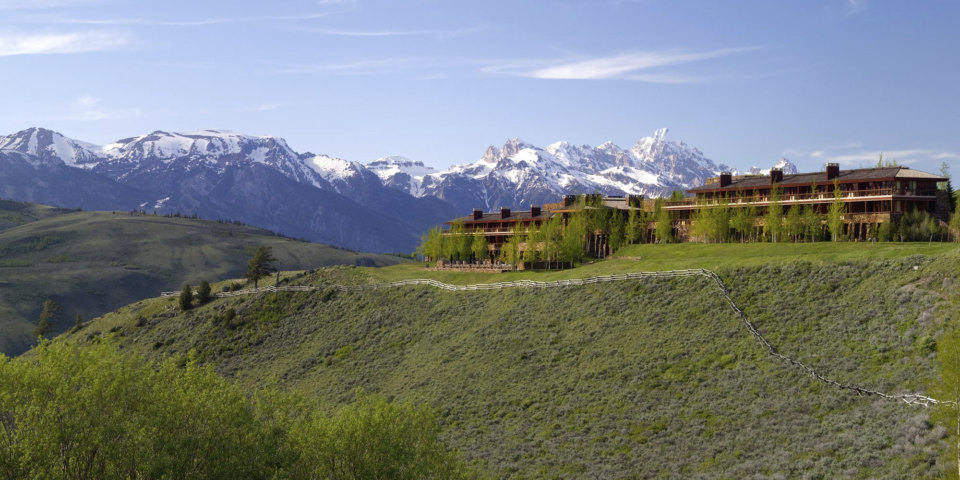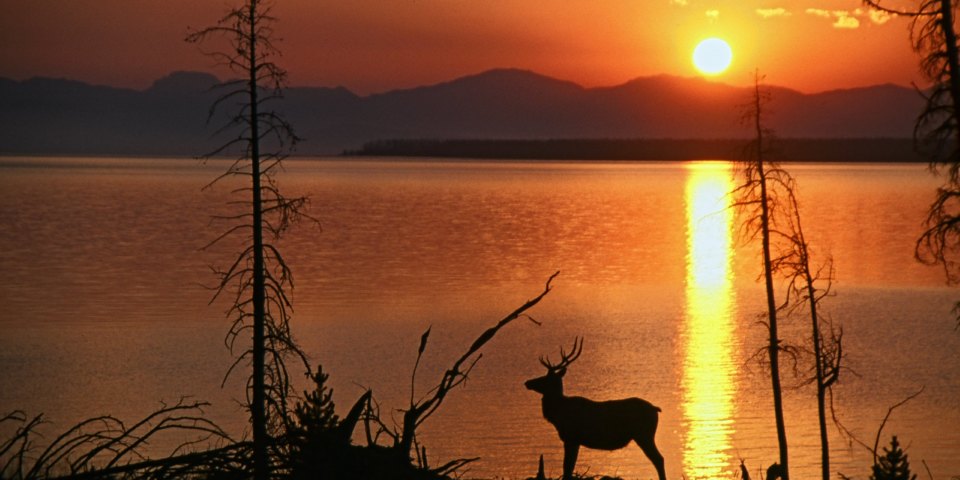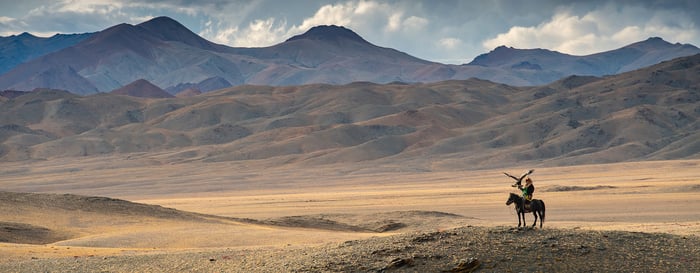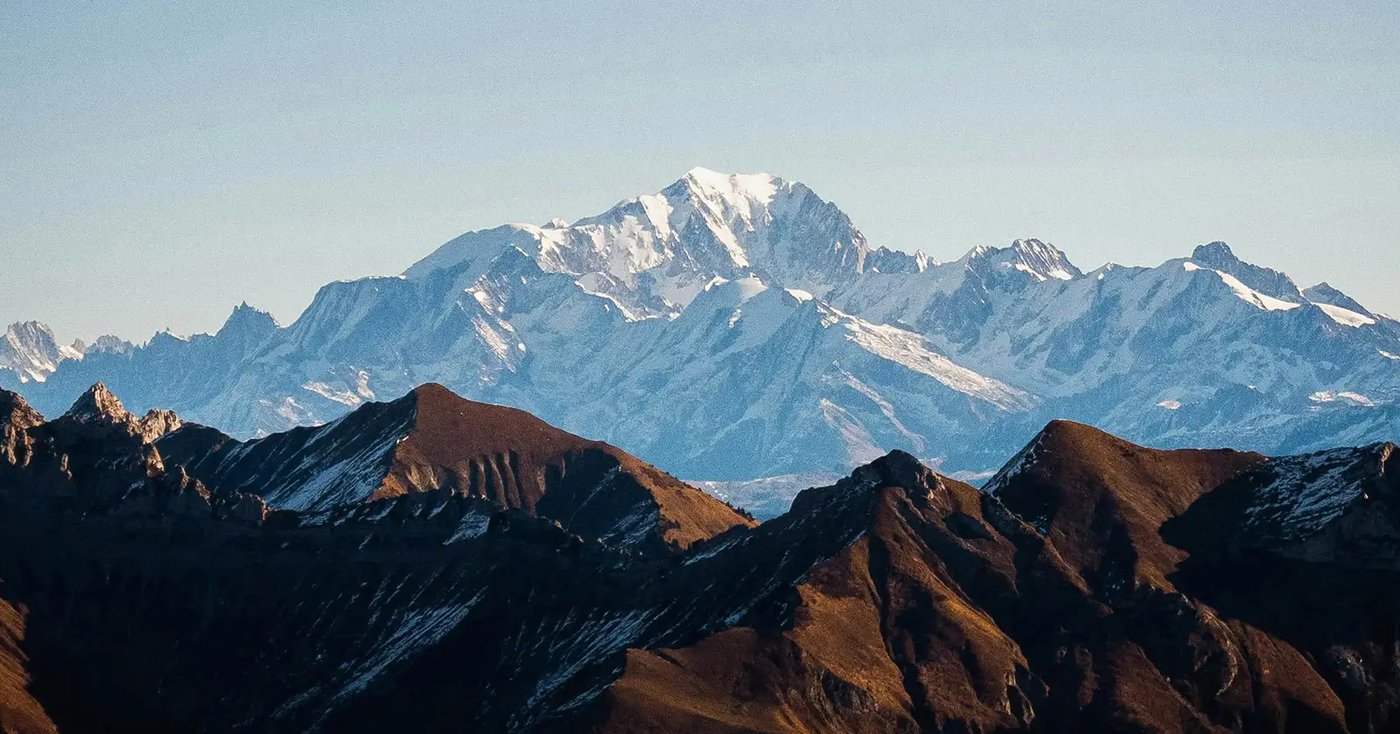Bears, Paul tells me as we get ready to depart, are the animals that most guests want to see, but all the American Big Five are possible here. We start by scanning the hotel’s impressive vista for signs of life. Amangani sits on a bluff overlooking the Snake River’s verdant floodplain and the snowy peaks of Grand Teton National Park. The landscape forms part of the Greater Yellowstone ecosystem and is home to all the animal icons you expect to see on a tea towel or postcard. Paul points out some brown dots in the distance which could be a herd of elk, so we fire up the engine and set off for a closer look.
We stop again within minutes, before we’ve even left Amangani, for our first animal sighting of the day. Paul’s trained eyes have spotted movement as we’re driving down the bluff’s wooded flanks. A young moose, a yearling, is emerging from the aspens with its mother close behind. They canter across the hillside on preposterously long legs – an adaptation, Paul explains, for manoeuvring in deep winter snow.
Driving on through the flatlands, those brown dots we’d seen from above do indeed turn out to be elk. Having grazed all night on the open plain, they’re returning to the safety of the woods where they’ll spend the day relaxing. We pull up and they cross the road in front of us, close enough to admire the bulls’ half-grown antlers encased in velvet, before disappearing into the trees. Before we pull off, we scan the plain with binoculars and spot a dog-like creature trotting purposefully across the pasture. Not a wolf, alas, but its cousin the coyote, its fur dark and heavy with morning dew. It searches the grass for a breakfast of mice before wandering out of sight.
Continuing into the National Park, the grasslands give way to sagebrush flats where sunburst blooms of arrowleaf balsam add splashes of bright spring colour. These mountain-flanked flatlands give Jackson Hole its name (‘hole’ being an old word for valley) and were created thousands of years ago by meltwater from a mile-thick ice cap. Sagebrush is the bison’s preferred habitat; and sure enough, a group of these American icons comes lumbering over the plain with a cohort of dainty pronghorn antelope. Once numbering in the region of 60 million animals, these giant bovines are descendants of the last 50 or so individuals that survived the wanton annihilation of the herds in the 1800s and for whom the establishment of Yellowstone National Park came just in time.
With three of the Big Five now crossed off the list, our focus shifts to the predators. Wolves and bears, Paul admits, will be harder to come by, but his knowledge of the animals’ habits should give us a fighting chance. At this time of year, grizzly bears descend on riverside willow thickets, knowing that moose like to gather here to drop their calves – a bear’s favourite food.
We stop to scan a suitable expanse of willow from an elevated lookout, beyond which the Tetons swim in and out of view among drifting clouds. Our attention is grabbed by a ghostly pale Northern harrier on the hunt for small birds, and further away we spot a metre-tall sandhill crane stalking through the sedge; but the animals we seek are clearly not going to show themselves here today, so we cut our losses in favour of trying somewhere else.
We relocate to Oxbow Bend, a renowned beauty spot on the Snake River where pelicans and bald eagles frequently gather to fish in the slow-flowing waters. We spot both species within minutes, and Jared points out an eagle’s nest at the top of a long-dead pine. Grizzlies eat fish too and they are known to frequent this place; and indeed, the telltale cluster of cars and tour buses down a track suggests that bears might be nearby.
But encountering grizzlies in such crowded company is not quite the wilderness experience I’m after. Instead, we head to Signal Mountain, a reliable site for black bears. With nobody else here, we have the mountaintop to ourselves and sit back on the grass to scan for wildlife.
Black bears – smaller and more numerous than grizzlies – like to eat dandelion flowers in spring, so we’re hoping that one or two might appear in the meadows far below. While we wait, a mountain bluebird serenades us with his cheerful song and a couple of ravens fly overhead with distinctive “kronking” calls.
Luck, however, is against us. The bears fail to show; but no matter, as the landscape itself is sufficient reward. Below us, the river wanders across this valley of its own creation in a scene framed by the mighty Tetons and dotted with bison and antelope. No roads; no houses; no people. It’s a wonderful glimpse into what the Wild West must have looked like centuries ago. And although my day is turning out to be bereft of bears, I’m happy just knowing they’re out there somewhere in this epic wilderness.
Mongolia for Families
Ulaanbaatar & Central Heartland
- The kids will love the experience of sleeping in traditional Mongolian felt tents, or ‘gers’
- Whether it’s horse ack riding or walking, get the kids out in nature and be active all throughout this holiday
- Learn about Mongolian culture first-hand by staying alongside a nomadic host family, helping them with their daily chores and letting the kids play and interact with the host children
Overland Safari Through Patagonia
Chilean Patagonia Argentine Patagonia Chile
- Cruise the Patagonia fjord to the Balmaceda and Serrano Glaciers
- Experience Patagonia like a local with a horse-riding excursion through the steppe
- Explore the Perito Moreno Glacier on a cruise or ice-trekking trip
- Discover the highlights of Torres del Paine, including the magnificent Grey Glacier
- Witness the majestic landscapes of Chilean and Argentine Patagonia
Trekking in Mongolia
Ulaanbaatar & Central Heartland
- A camping trek through some of the most remote parts of Mongolia, the western Altai Mountains
- Meeting the famed eagle hunters and staying alongside a host family
- Exploring some of the most beautiful parts of Mongolia’s heartland, including the stunning Orkhon Valley
- Spending the night in Mandala Mongolia – the most luxurious and intimate accommodation available in the country







